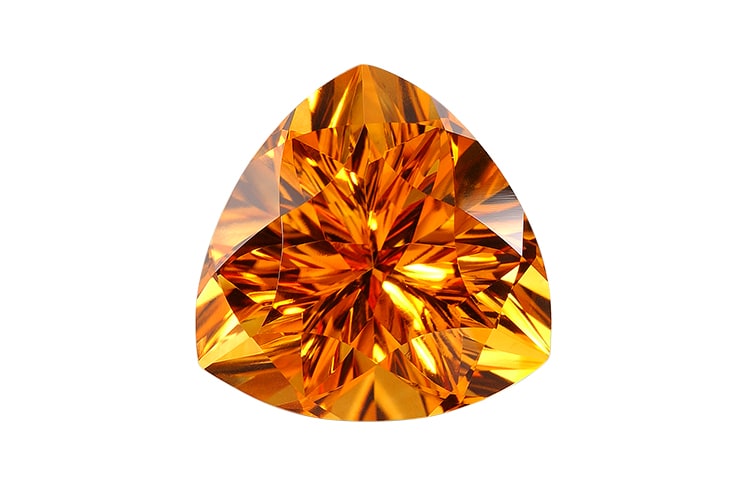Guide to Citrine

History, Lore and Appreciation
The description for citrine is contained in its name. Citrine, from the French word citron literally means “lemon,” in deference to a multitude of rich yellow hues. There are several sources for the gem, and consequently the gem is readily available.
Citrine actually covers a much wider range of yellows than do most lemons, including rich, orangey yellow colors and deep orange. Some citrines may be reminiscent of a gem from a different species called topaz. There is no relation between topaz and citrine whatsoever, despite misnomers such as “smoky topaz”, “quartz-topaz” or “Madeira topaz” which are sometimes incorrectly used to describe a particular hue of citrine quartz. In fact, citrine has significant attributes of its own to stand upon: aside from its rich and optimistic colors, it is found in an impressive range of sizes and quantities, making it a favorite for gem carvers.
While citrine is found in nature, the majority of the gems used in jewelry began as amethyst, which was been heat-treated to change its color. Citrine is greatly esteemed for its warm, earthy colors and vivacious sparkle, especially among lighter toned gems.
Birthstones and Anniversaries
Citrine is one of the birthstones for November, along with topaz. It is also considered a 13th wedding anniversary gem.
Description and Properties
Citrine is a variety of quartz that grows in the trigonal crystal system and has the following chemical composition: SiO2.
Color(s): Citrine is transparent to translucent pale yellow to deep orange and/or brownish orange.
Refractive Index: 1.544 to 1.553 Birefringence: 0.009
Specific Gravity: 2.66 (+0.03, -0.02)
Cause(s) of color Traces of iron are the principal cause of yellow. Heat treatment of some amethyst under controlled conditions also causes yellow to brownish yellow colors.
Mohs Hardness: 7
Internal identifying characteristics: Citrine is often devoid of eye-visible inclusions though some material may show color zoning. In some cases, fluid inclusions and negative crystals may be seen. Inclusions of other minerals such as goethite or rutile can also be found in citrine.
Treatments
Most citrine starts out as amethyst that has been heat treated to turn it yellow to yellowish brown. Heat treatment of amethyst requires considerable experience, and not all amethyst responds in a manner that is expected. However, altered color is considered stable.
Collector Quality
Collectors of citrine look for a pure yellow or orange color to begin with. Lapidaries (gem cutters) often work with citrine
to make unusual carvings or cuts, which are also highly prized. Because ametrine – a form of quartz that combines the colors of amethyst and citrine – comes essentially from only one region in the world, it is collectible if the depth of color and the division of color is strong, or if it has been cleverly carved and fashioned.
Localities
Brazil is one of the main sources of citrine; particularly from the gem rich states of Minas Gerais and Rio Grande do Sul. Bolivia’s Anahí mine has also become a leading producer of citrine. It is also found in Uruguay, as well as in African countries such as Tanzania, Madagascar, Namibia and Zambia.
Cutting, Care and Cleaning
Citrine is one of the most plentiful gems in the market. It can be found in many sizes. Citrine is often cut as large gems or in carvings. Citrine is also fairly resilient and may be worn extensively, though wearing citrine during any type of manual labour or strenuous activity should be avoided. Care should be taken not to knock the gem during use, as small fissures or cracks may develop, especially along facet junctions. It is best cleaned with warm, sudsy water or a damp cleaning cloth.
Source: CIBJO Retailers’ Reference Guide